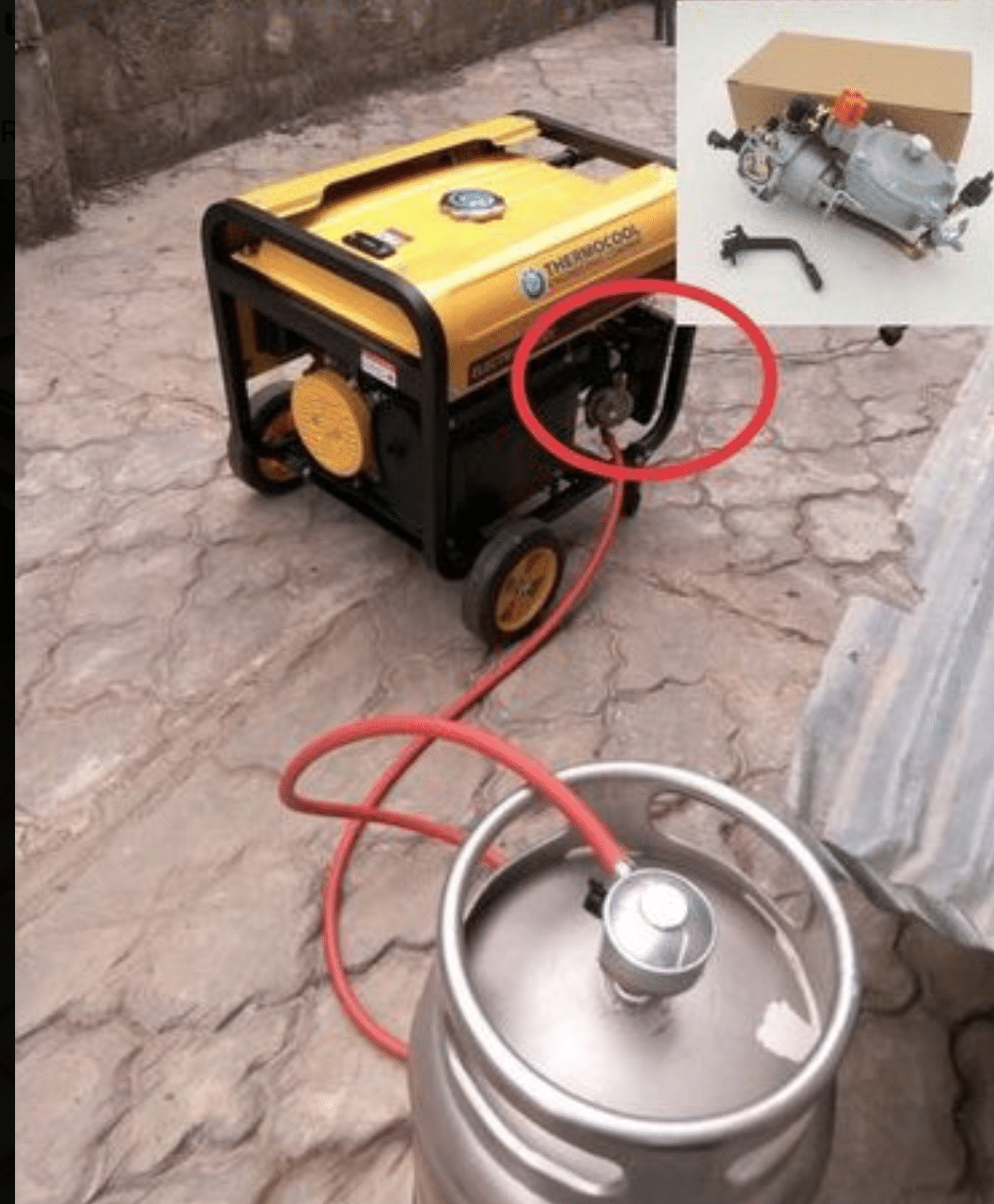Gist
Fuel Subsidy Removal: Safety Ways To Prevent Fire Outbreak When Converting Petrol Generator To Gas

The impact of fuel subsidy removal by the administration of President Bola Ahmed Tinubu, has led to the hike in the pump price of petrol from N185 per litre to an average of N600, pushing a lot of low-income Nigerians who are heavily fuel-reliant into untold hardship and stress.
With the prices of petroleum products rising spontaneously and the growing erratic supply of electricity by the Nigerian Electricity Regulatory Commission, NERC, low-income earners seems to have adopted a cost-efficient way by veering towards conversion of petrol generators to Liquified Petrol Gas generators, which is seen as a cheaper alternative means of generating power for themselves.
According to reports, cooking gas is widely popular in Nigeria, especially in urban areas. As of June 2022, the roughly 9 million households that use clean cooking fuel are concentrated in urban areas and overwhelmingly rely on LPG (cooking gas) as their primary cooking fuel.
The inherent advantages are that cooking gas is generally cheaper and overwhelmingly cleaner; and while the price of petrol seems unstable, the cost of cooking gas is getting lower, as several users have noted.
According to Asiko Energy Holdings, as reported by Nairametrics, “The cost and consumption rate comparison shows that using a 12.5kg gas cylinder to power the generator offers approximately 15 hours of electricity at a cost of N500 per hour while using petrol for the same duration requires 30 litres and costs ₦1,050 per hour.”
But How Safe Is This?
However, there are growing concerns about the safety of converting petrol-powered electricity generating set to the far cheaper liquified petroleum gas (LPG), better known as cooking gas.
In an interview with Naija News, the Chief Fire Officer of the Lagos State Fire Service, Amodu Shakiru, guaranteed safety only if residents tilting towards that direction use the help of qualified technicians in their conversion process.
He added that subsidy acted as a reasonable radiant in aligning Nigerians with the rest of the world in phasing out fossil fuel and adapting the use and promotion of environmentally friendly fuel, which is gas.
He said: “Emission by fossil fuel in terms of diesel, petrol is telling so much on the world especially in the impact on climate change. The usage of gas generator is also the right way to go.
“Because fossil fuel is being phased out worldwide, and Nigeria should not be an exception, we should join the bandwagon.
“We need to align with the rest of the world in promoting environmentally friendly fuel, which is gas. Subsidy is just a good omen to the usage and promotion of gas in powering generators because we have to stop emission.
“This is why I said, it is a good radiant as far as the issue of subsidy is concerned.
“Although it has its associated risk, we can work around it, if everyone becomes careful, conscious of its usage; then it is the way to go.”
Precautionary Way To Convert PG To LPG?
Amodu said: “The usage of a gas-powering generator is in two ways: it is either you want to buy an already established generator which is powered by gas or convert your old or existing generator which formally uses petrol or diesel to gas. Either way, you need to look at the risk involved.
“Firstly, if you are converting, you need to get a certified technician to do that, and not just anybody, and by being certified, one will have obtained certification on the field. Another step to consider is to understand the exposure to high concentrations of gas and the health implications.
“It is essential not to expose oneself to the usage of gas; but as long as you can protect yourself and others from direct contact with gas then you have no problem.
“One has got to also understand that ignition of gas can also lead to burns and explosions. Exposing yourself to it could lead to burns due to how highly flammable it is. Then, the leakage of gas, which is prominent amongst those who use gas must not be played with. That’s why getting a specialized technician to help with conversion or installation is essential.
“This is because you are connecting two ends (the gas cylinder end to the generator powering the end, you’ll need a valve and host, and this is where a good sense of smell comes into play. We also advise that those who want to use gas must have a good sense of smell.
“Alternatively, if you don’t have a good sense of smell, you can also use a gas leakage detector to help with leakage. It is important to shut down the cylinder when you sense a leakage, whether by smell or gas leakage detector during usage. It is also essential to understand that the corrosiveness attached to the gas cylinder should be considered because it brings about an atom of leakage.
“Avoid exposing the gas cylinder to direct sunlight or rainfall is harmful. This is not saying that you need to build a cage for your gas cylinder, whereas in a place that is not properly ventilated.
“By building a cage, this means, building an open cage or getting a chain during installation.
“It must be used outdoor. Gas cylinders must be used outdoors and never indoor whether used for powering generators or cooking.”
How Best Can We Use Gas Cylinder With LPG?
Amodu stressed that converting petrol-powered generators to cooking gas-powered may be safe; however, the circumstances around its usage, including placement maintenance, could make it dangerous.
He noted that a gas explosion rarely has any survivors, and people must look at gas cylinders as a time bomb, which will help them operate around the cylinder more carefully.
In how best to use a cylinder when powering a generator, Amodu said: “Firstly, you must look at where one intends to mount the cylinder to prevent an explosion because of the temperature. When a cylinder is exposed, it generates heat, which can be dangerous because the generator is already generating heat.
“You need to position your gas cylinder in the open so that it can be ventilated. A simple way of positioning is: if your gas cylinder is on the left, your generator must be on the right and must be five meters apart.
“Before you ignite your generator, you must make sure your power changing source is on neutral. This is because, if you have your changeover switched on to power your system, this may trigger an explosion or generate a very high current, which may lead to the damage of some electrical appliances in the home. So it must stay neutral.
“It is imperative that cylinders are not positioned inside the house, if anyone positions their gas cylinder inside, then they are on a suicide mission because if anything goes wrong, it will be difficult to shut down or arrest the fire.
“Even for firefighters, gas-induced fire are quite difficult to arrest; this is why we lay emphasis on placing the cylinder outdoors so it’d be easy to shut it down during an incident.
“Another safety precaution people must adhere to is, ensuring that the cylinder is standing upright during refilling. It is risky to place it on your shoulders or on the vertical side because of its colourless nature, which, in case there’s leakage, would be easy to detect.
“It is also best to have your cylinder placed at the back seat of your car and not inside the boot and make sure no one sits beside the cylinder.
“It is also best to turn off your AC and use normal ventilation. Taking your cylinder from the point of refill to the point of usage, with no quick stops, is paramount.”
He added that using gas-powered generators is the way to go, but safety precautions must be well established.












